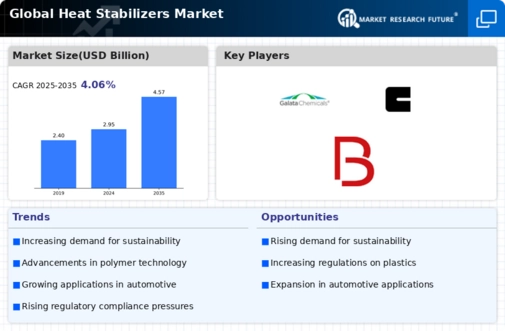Market Analysis
In-depth Analysis of Heat Stabilizers Market Industry Landscape
The market dynamics of Heat Stabilizers are shaped by a multitude of factors that influence the demand, supply, pricing, and overall trajectory of this industry. Understanding these dynamics is crucial for stakeholders to navigate the ever-evolving landscape.
One of the fundamental driving forces in the Heat Stabilizers market is the demand generated by various industries. The construction, automotive, packaging, and electrical industries heavily rely on Heat Stabilizers for enhancing the durability and performance of their products. Consequently, any shifts or advancements within these sectors directly impact the demand for Heat Stabilizers. For instance, trends in urbanization, infrastructure development, and technological advancements in these industries influence the type and volume of stabilizers required.
Raw material availability and pricing significantly impact the Heat Stabilizers market dynamics. The primary constituents of stabilizers, including metal compounds and organic acids, are subject to market fluctuations and availability. Variations in the prices or scarcity of these raw materials directly influence the production costs, thereby affecting the final pricing of Heat Stabilizers in the market. Manufacturers closely monitor these factors to maintain profitability and competitiveness.
Government regulations and environmental policies play a pivotal role in shaping the market dynamics of Heat Stabilizers. Increased emphasis on sustainability and environmental concerns has led to stringent regulations regarding the use of certain stabilizers containing harmful components like heavy metals. This has triggered a shift towards eco-friendly alternatives, compelling manufacturers to invest in research and development for compliant and environmentally safe products. Compliance with these regulations not only impacts the manufacturing processes but also influences consumer preferences, driving the market towards greener solutions.
Technological advancements drive innovation and competitiveness within the Heat Stabilizers market. Companies continuously invest in research and development to develop advanced stabilizers that offer improved performance, better heat resistance, and reduced environmental impact. Innovations in manufacturing processes and formulations contribute to cost-efficiency, quality enhancement, and the development of new products, thereby shaping the market landscape.
The global economic conditions and market trends have a substantial impact on the Heat Stabilizers industry. Economic fluctuations, trade policies, and geopolitical tensions affect market growth, investment decisions, and consumer behavior. Additionally, emerging markets with increasing industrialization and infrastructural development contribute to the expansion of the Heat Stabilizers market.
The competitive landscape significantly influences market dynamics in the Heat Stabilizers sector. Intense competition among key players drives innovation, pricing strategies, and market expansion efforts. Companies engage in mergers, acquisitions, or strategic partnerships to consolidate market share, access new technologies, or broaden their product portfolios, thereby influencing market dynamics.
Consumer preferences and awareness are pivotal in shaping the Heat Stabilizers market. Growing awareness of environmental issues has led to a shift in consumer preferences towards sustainable and eco-friendly products. This shift in demand has propelled manufacturers to focus on developing and promoting greener alternatives, influencing the market dynamics and product offerings.







Leave a Comment